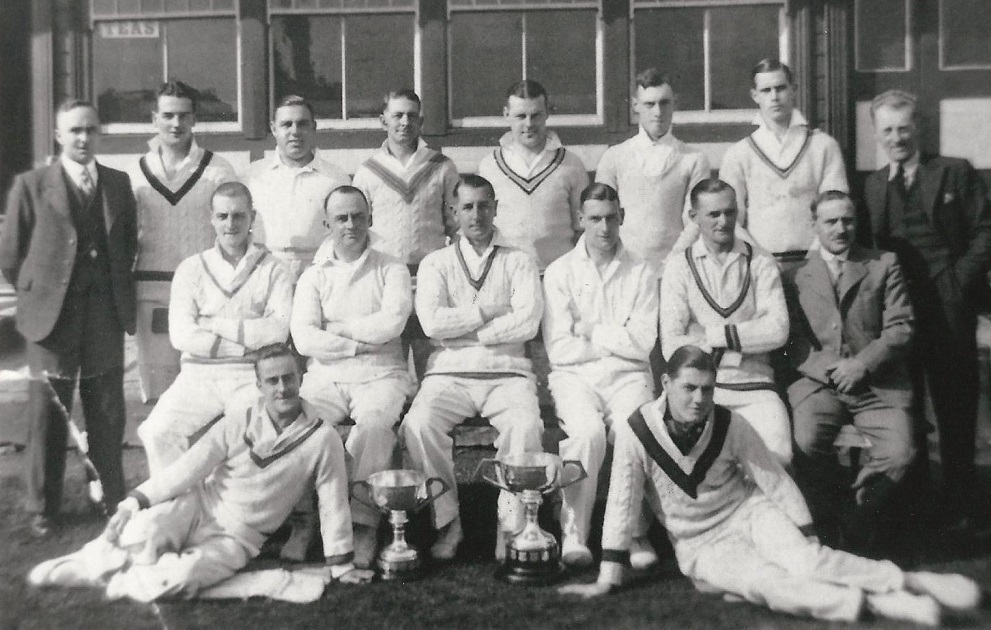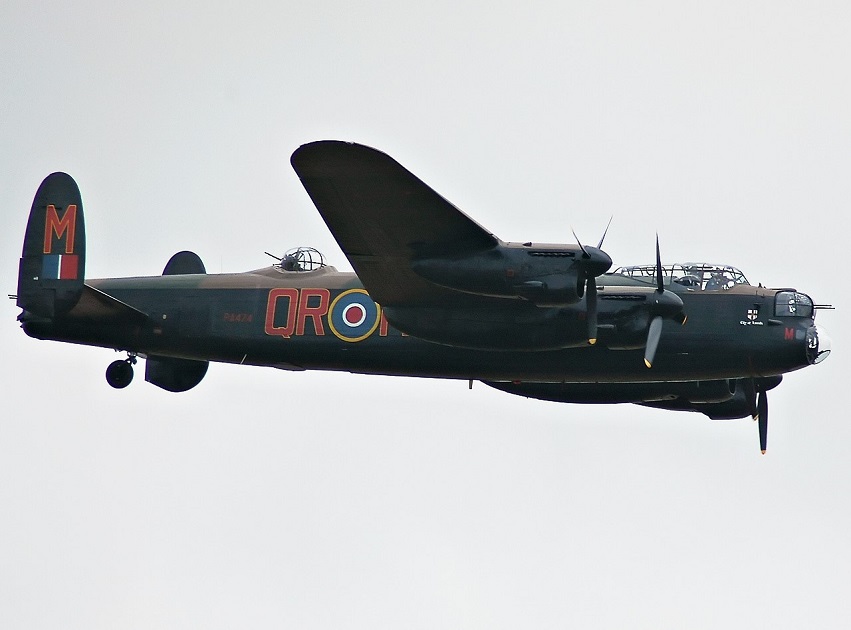| Title | A Teenager in Wartime Yeadon |
| Date | 1939 – 1945 |
| Location | Yeadon |
| Written By | John Denison |
| Comment | Read on… |
One thing we kids were interested in was aircraft crashes which we would visit hoping for souvenirs.
Of course these were our own plane…s but I am afraid that didn’t worry us unduly, it was a kind of adventure.
In the field near the Long Stoop a Hurricane crashed and was in three sections, the tail unit, and a long way forward, the propeller.
Another crash visit was at the Horsforth end of Bayton Lane, this was, I think, a Wellington.
Being late on the scene there was already a military presence and we could not get near.
Before the war I had joined the St. Andrews Boy Scouts when it was founded by Tommy Dennison and George Atkinson.
With the start of the war some of us became War Service Scouts and our main function was to go round with a handcart collecting waste paper which was massed in Mr. Atkinsons largish garage until, when packed to the roof, it would be collected by the authorities for the ‘war effort’.
At school I had jumped a class and ended up in Standard 8 for some two years, this was the ‘leaving class’ where, at the age of 14 you left to take up employment.
The ones in this class were those who had failed the ’11 plus’ exam to get into Secondary School.
I had been expected to pass but, there you go, I did not.
I was not the only failure, another was a certain Jimmy Rawnsley who went on to become a solicitor and Chief Executive of Leeds Council.
Our teacher in this class was Sidney Smith, a well known local cricketer.
Being about to go to work, ended my three year career as a newspaper boy.
For the whole period I had a morning ’round’ for Laura Myers whose shop was in the High Street.
I covered quite a large area of North-Eastern Yeadon which extended as far as the cemetery, I delivered some fifty-odd papers.
Presenting myself at the shop at 6-30 the first job was to sort the papers into the order in which they would be delivered.
At first the destination was written on the top of the paper but I soon memorised who got what and discarded this part of the operation.
Thinking back it must have been quite a struggle being so small because all were ‘broadsheets’ at that time with many pages.
Most times I carried a large paper bag but I also made use of a ‘bogie’ (a soap box on pram wheels) or my bike and, in winter, my sledge.
In the last year I also had an evening round for Parkers which covered the area of Brookland and Henshaw Lane.
The morning job paid five ‘bob’ a week and the evening half a crown on top of which one got tips.
At the end of 1940 I became 14 and graduated to ‘long trousers’, shorts being the general rule until you reached that age.
I was now eligible to join the working class!
I sought after an ‘office job’ and my Dad managed to get me an interview with Arrow Aircraft in Harrogate Road which I duly attended and was taken on with the proviso that I should ‘go on the floor’ as currently there was no office vacancy.
I joined a man called Tom Cross and his mate who produced sheet aluminium tail units for bombs.
My job was to take the completed units to the Welding Section who performed their job and I then had to scrub the welds in a hot-water tub.
I must have been good at this menial task as I was ‘promoted’ to Welding who were working on damaged landing lights from various aircraft.
Again I was back to scrubbing but when the ‘run’ finished I was sent to the Fitting Shop where the foreman was Arthur Smith the father of a friend John, I found him to be a strict taskmaster.
I really did not like this work which involved, by use of different files, the removal of burns left from lathes.
We were on bonus, which meant I could earn more but, especially when working on small screws, the fingers were almost ripped to shreds.
So, I moaned, and was eventually moved on.
In the Fitting Shop we were not all just ‘dogsbodies’ and fame was to be earned.
A former school mate Frank Mathews, became ‘War Worker of the Week’.
He was on a bench fitted with eight Browning machine guns as fitted to fighter aircraft where the oil-pressure required to fire guns was tested – now I wouldn’t have minded that as a job!
But poor Frank was mercilessly ragged when a newspaper ad appeared saying the he ate Shredded Wheat for breakfast.
I hope he was well paid for that.
My next job was in the inspection department run by Mr. Barnes where I worked with about six young females.
I wasn’…t there long, maybe this was because, looking so childlike, I was mollycoddled by the girls.
Where did I go next, of all places but the canteen where, among other things, I filled the potato peeling machine.
Another task was on a Friday I think, to go round the shop floor taking orders for fish and chips and off I went to Waites on Albert Square after which I struggled back with up to thirty orders.
Then, at last, I got my job in the office where my main task was to hand write the machine time-cards for the following week.
As I recall there were about 230 and I was, rightly, proud of the fact that, after a few weeks I did not have to refer to the lists as I could remember all of the names and numbers.
I was called upon to do other things one which occurred weekly was when I had to go to Green Lane Post Office to obtain the ‘health stamps’ which were to be affixed to employees contribution cards.
Quite a large amount of money was involved which would be placed in a leather box locked in the office and could be opened with a key held by the PO where the stamps would be inserted.
Supposedly this was a precaution against theft but thinking back wasn’t this somewhat futile as the thief would take the lot.
Could it have been that the lack of trust was in the carrier?
I did find one of my duties interesting.
My firm had arranged to borrow a diamond cutting tool from Avro and I was sent to collect it.
I reported to the reception centre where, to my surprise, I was given a bicycle and was to be escorted by another to the collection point.
I found that there was a track all the was round this huge factory with by-ways leading off to the various departments.
My companion was perhaps not as security minded as he should have been since he asked me if I would like to see something secret.
He took me to an area surrounded by canvas screens, found a gap and I looked in to get a major shock.
I saw an enormous aircraft towering above me.
Although I was interested in ‘aircraft recognition’ I didn’t know that such large planes existed.
It could have been either a four engine Lancaster or its predecessor the twin engine Manchester – I was so astonished I did not count the number of power plants
As an aid to my aircraft recognition skills I would, on my way home from work call in at Parish’s Newsagents at Fountain Cross Roads to …purchase my copy of Aircraft (or Aeroplane) Spotter magazine at 3pence a time.
This contained silhouettes and pictures of different, difficult angles and in the distance.
The factory had a ‘spotters box’ perched above the roof which was permanently manned, in the early days, by two men who did shifts up there.
I often visited and discovered that they knew little about identifying aircraft being tasked with sounding the warning siren if planes were seen in attack.
It was fortunate that this never happened as it would have been much too late for people to take shelter.
I did not go up there much in winter since it was just a wooden box with a roof and openings at shoulder level so that, despite having a little stove, it became very cold.
A cousin who was now serving with the RAF had been head of Accounts Department at Kirkstall Forge who were known to be good employers taking on youngsters who advanced through their system and could eventually become department heads.
I applied for a job there and was gratified to be told that I would be taken on but it wasn’t that easy because, at that time, one had to approach the Labour Department and make your case for a change of employment.
Fortunately this was granted and at the age off fifteen and a half I joined the Post Room at a wage of 15shillings and sixpence per week.
As I am supposed to be talking about Wartime Yeadon anything specific about this employment is irrelevant.
I travelled to and from work by taking the 32 Leeds bus which started from Albert Square.
Getting home was not always as easy as the 32 had filled up in Leeds and did not stop which meant boarding a Leeds City Transport bus to either Rawdon traffic lights or Henshaw Lane and walking the rest.
In those days fog/smog was often present and this could complicate homeward travel.
I would, in suitable weather do the trip by bike thereby saving the fare to increase my pocket money.
It was a bit of a nuisance having to carry, in addition to my sandwiches, my gas mask which was now in a circular canister.
The journey to Kirkstall was speedy but as readers know it is a long upwards haul to Yeadon so I always hoped for a slow-moving lorry which I could grab and get a tow.
Top Photo shows Sidney Smith in 1946
Middle photo is an AVRO Lancaster’
Bottom photo is a painting of the interior of Kirkstall Forge.
August 2013
Previous Comments:
teleg
Do you remember Syd Smith’s tales of ” When I was out in Salonika”, where no doubt he had been in the first world war.
Someone else from our old school days whom I met in Morrison’s car park was Ronnie Walker who used to live on Rufford but now lives in the North around Newcastle and had come down to attend someone’s funeral.
08 September 2013.




